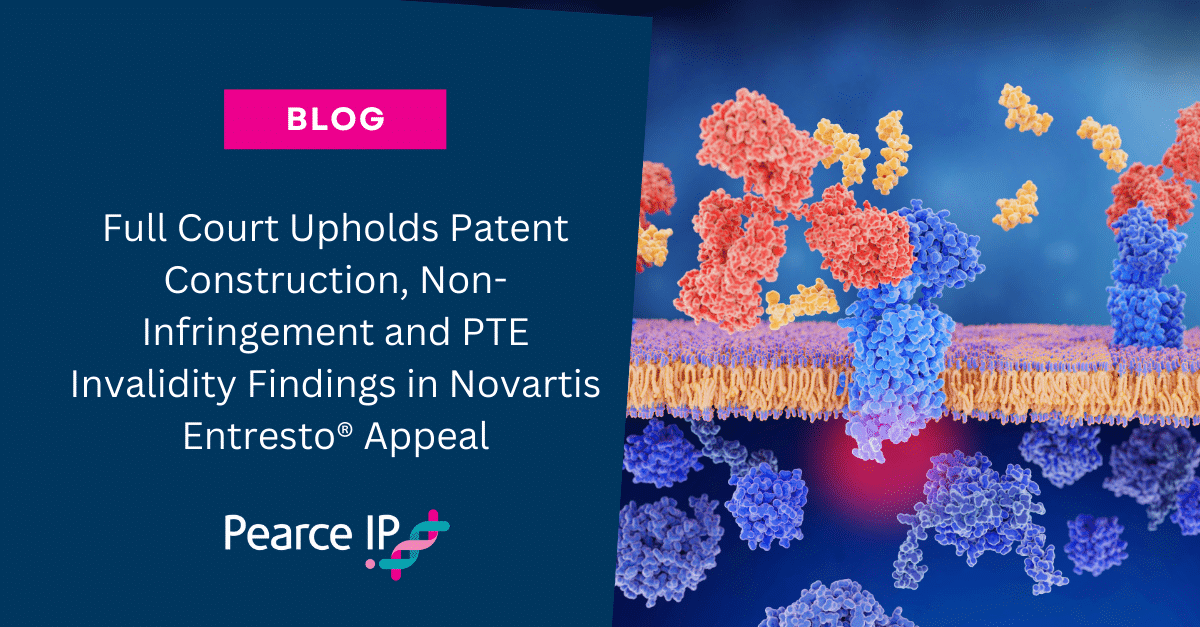| Date of decision: | 19 March 2025 |
| Body: | Full Court of the Federal Court |
| Adjudicator: | Justices Burley, Rofe and Downes |
Highlight
In a unanimous decision, Justices Burley, Rofe and Downes of the Full Court of the Federal Court dismissed Novartis’ appeal against the first instance decision of Justice Yates in which his Honour found that Pharmacor’s sacubitril/valsartan generic products do not infringe Novartis’ composition patent AU2003206738 relating to Novartis blockbuster Entresto® and that Novartis’ patent term extension (PTE) was wrongly granted. The Full Court agreed with the primary judge’s findings on construction upon which his Honour’s findings on infringement and the PTE were based. In doing so, the Full Court affirmed the central importance of claim construction and the need to give words their ordinary meaning when determining the scope of the claims. Novartis has now exhausted all appeal avenues, with the High Court dismissing Novartis’ special leave application with costs on 7 August 2025.
Novartis’ Entresto® empire has also now been opened to generic competition in Australia with the PBS-listing of sacubitril/valsartan generic products by Pharmacor and Apotex and a secondary brand from Novartis.
Background
Novartis AG and Novartis Pharmaceuticals Australia Pty Ltd (together, Novartis) are the owners of patent AU2003206738 entitled “Pharmaceutical compositions comprising valsartan and NEP inhibitors” (the Patent). Claim 1 of the Patent is directed to a pharmaceutical composition comprising:
(i) the AT 1-antagonists valsartan or a pharmaceutically acceptable salt thereof; and
(ii) the NEP inhibitor [sacubitril] or [sacubitrilat] or pharmaceutically acceptable salts thereof; and
(iii) a pharmaceutically acceptable carrier.
The claimed pharmaceutical combination/composition is for the treatment or prevention of hypertension, heart failure, and myocardial infarction.
This appeal stems from the primary decision in Pharmacor’s favour delivered by Justice Yates in November 2024 holding that Novartis had not established that Pharmacor threatened to infringe claim 1 of the Patent, and that the term of the Patent had been wrongly extended. The term of the Patent had therefore ended on 16 January 2023, three months before Pharmacor’s April 2023 sacubitril/valsartan generic ARTG registrations. This appeal was expedited as the Department of Health required Pharmacor to withdraw its PBS application by 24 March 2025 if the matter remained unresolved.
Key Issues and Consideration
The central issue on appeal concerned the proper construction of claim 1 of the Patent, the determination of which would resolve the questions of infringement and the validity of the PTE. The key question was whether integers (i) and (ii) of claim 1 were satisfied by a complex containing anionic valsartan, anionic sacubitril and pharmaceutically acceptable cations (such as sodium cations).
At first instance, Novartis argued that claim 1 was directed to any pharmaceutical composition including a carrier that delivers valsartan and sacubitril/at as the relevant active agents or ingredients, and in particular that:
- there was no limitation in claim 1 that excluded a pharmaceutical composition in which there were non-covalent bonds between the valsartan and sacubitril; and
- claim 1 did not require that integers (i) and (ii) be discrete physical substances, each with a unique set of physicochemical properties.
At first instance, the primary judge held that the invention of claim 1 was not defined in terms that implied that integers (i) and (ii) were combined to produce a new chemical entity, being a unique, single entity with its own properties. Novartis advanced numerous criticisms of the primary judge’s reasoning on the construction of claim 1 through multiple grounds of appeal.
For the following reasons, the Full Court was unable to detect error on the part of the primary judge in reaching his conclusion as to the construction of claim 1 (which are detailed in our report on the first instance decision):
1. Nature of the Claim: The Full Court found that claim 1 was for a pharmaceutical composition. Integers (i) and (ii) served to identify the characteristics of the product. The words “the AT 1-antagonist valsartan” in integer (i) served to identify first, that the component must be an AT 1-antagonist and secondly, that it must be valsartan or a pharmaceutically acceptable salt thereof. The words “NEP inhibitor” in integer (ii) were to be understood in a similar way. So, the skilled person would understand that integer (i) of claim 1 could not be satisfied by something that also satisfies integer (ii).
2. Distinct Components Required: The Full Court agreed with the primary judge’s finding that claim 1 did not claim, through integers (i) and (ii), a complex formed from valsartan and sacubitril/at or their pharmaceutically acceptable salts. The conjunction “and” between integers (i) and (ii) indicated that there must be both the AT 1-anatagonist of integer (i) and also the NEP sacubitril/at of integer (ii) in the composition, as distinct and separate components.
3. Expert Evidence: The experts agreed that:
- the composition of claim 1 included two active pharmaceutical ingredients or their pharmaceutically acceptable salts;
- claim 1 required two salts; and
- in contrast, a complex was a singular entity or one salt.
4. Product v Preparation: The Full Court agreed that claim 1 was a product claim relating to the state of components when in the pharmaceutical composition as prepared, not to components involved in preparing a pharmaceutical composition or something that happened after administration, including how it worked in the body.
5. ‘Double Salt’ is a Single Salt: The Full Court held that the primary judge relied on sound scientific justification for concluding that a salt complex or “double salt” did not fall within the scope of claim 1, such that a “double salt” was a single salt with neither the properties of a salt of valsartan nor the properties of a salt of sacubitril/at.
6. Support from the Specification: The Full Court found that the primary judge had appropriately considered the specification to support his construction. Passages in the specification referred to components (i) and (ii) as separate components which could be administered “together” (meaning one after the other, not as a complex) or “separately” (the components being separate in one combined unit dose form, or in two separate unit dose forms that was not administered ‘together’). So, the specification supported the construction that claim 1 did not include a complex formed from those components.
7. Preparation in Solution: The Full Court rejected Novartis’ argument that it would be a perverse outcome if the claim encompassed a solid of salts, but, when the salts were put in solution as a means of administering them, they were not within the claim. The primary judge had found that a pharmaceutical composition in accordance with claim 1 could be prepared in the form of a solution, depending on the choice of an appropriate solvent.
The Full Court’s view on construction also resolved Novartis’ challenge to the primary judge’s findings of non-infringement and PTE invalidity. As Pharmacor’s generic sacubitril/valsartan included a single chemical entity consisting of sacubitril, valsartan and sodium associated by non-covalent bonds, it did not infringe the Patent. And, as Novartis’ Entresto®, being the ARTG-registered product upon which the PTE had been based, was a film-coated tablet that contained an active ingredient which was a salt complex of the anionic forms of sacubitril and valsartan, sodium cations, and water molecules, it followed that Entresto® did not contain or consist of the claimed combination, being (a) valsartan or a pharmaceutically acceptable salt thereof; (b) sacubitril or a pharmaceutically acceptable salt thereof; and (c) a pharmaceutically acceptable carrier.
Outcome
The Full Court concluded that no error had been shown in the primary judge’s reasons regarding the construction of claim 1. This conclusion on construction was determinative of all other grounds of appeal, including the patent infringement and PTE grounds. As the appeal was dismissed, it was unnecessary for the Full Court to consider the cross-appeal, notice of contention or application for interlocutory relief. The Full Court ordered that Novartis pay Pharmacor’s costs of the appeal, cross-appeal and interlocutory application.
Implications
The decision reinforces the Court’s strict approach to claim construction, giving effect to the ordinary meaning of the words, and rejecting constructions that inappropriately refer to the specification to broaden the meaning of claims. Critically, the decision also reinforces the central importance of claim construction to the issues of patent infringement and PTE validity.
About Pearce IP
Pearce IP is a specialist firm offering intellectual property specialist lawyers and attorneys with a focus on the life sciences industries. Pearce IP and its leaders are ranked in every notable legal directory for legal, patent and trade mark excellence, including: Chambers & Partners, Legal 500, IAM Patent 1000, IAM Strategy 300, MIP IP Stars, Doyles Guide, WTR 1000, Best Lawyers, WIPR Leaders, 5 Star IP Lawyers, among others.
In 2025, Pearce IP was recognised by Australasian Lawyer and New Zealand Lawyer’s 5 Star Employer of Choice, and is the “Standout Winner” for inclusion and culture for firms with less than 100 employees. Pearce IP was awarded “IP Team of the Year” by Lawyers Weekly at the 2021 Australian Law Awards. Pearce IP is recognised by Managing IP as the only leading ANZ IP firm with a female founder, and is certified by WEConnect International as women owned.

Naomi Pearce
CEO, Executive Lawyer (AU, NZ), Patent Attorney (AU, NZ) & Trade Mark Attorney (AU)
Naomi is the founder of Pearce IP, and is one of Australia’s leading IP practitioners. Naomi is a market leading, strategic, commercially astute, patent lawyer, patent attorney and trade mark attorney, with over 25 years’ experience, and a background in molecular biology/biochemistry. Ranked in virtually every notable legal directory, highly regarded by peers and clients, with a background in molecular biology, Naomi is renown for her successful and elegant IP/legal strategies.
Among other awards, Naomi is ranked in Chambers, IAM Patent 1000, IAM Strategy 300, is a MIP “Patent Star”, and is recognised as a WIPR Leader for patents and trade marks. Naomi is the 2023 Lawyers Weekly “IP Partner of the Year”, the 2022 Lexology client choice award recipient for Life Sciences, the 2022 Asia Pacific Women in Business Law “Patent Lawyer of the Year” and the 2021 Lawyers Weekly Women in Law SME “Partner of the Year”. Naomi is the founder of Pearce IP, which commenced in 2017 and won 2021 “IP Team of the Year” at the Australian Law Awards.

Helen Macpherson
Executive, Lawyer (Head of Litigation –Australia)
Helen has over 25 years’ experience as an intellectual property specialist and is recognised as an industry leader. Helen advises on all forms of intellectual property including patents, plant breeder’s rights, trade marks, copyright and confidential information.
Throughout her career, Helen has maintained a strong focus on high-value patent mandates involving complex technologies. In these mandates, Helen has been able to draw upon her technical training in biochemistry and molecular biology, as well as her ability to up-skill swiftly in relation to diverse technologies. Helen’s patent work has encompassed the technical fields of inorganic, organic, physical and process chemistry, biochemistry, biotechnology (including genetics, molecular biology and virology) and physics.
Helen is a member of the Intellectual Property Committee of the Law Council of Australia, as well as a member of the Intellectual Property Society of Australia and New Zealand.

Nathan Kan
Lawyer
Nathan is a lawyer specialising in life sciences, providing legal advice and litigation support across intellectual property and commercial disputes. He is passionate about the intersection of law and science, and during his time with the Science and Technology Law Association at the University of Melbourne, he helped lead events, workshops and publications across STEM fields including life sciences, AI and digital transformation.

